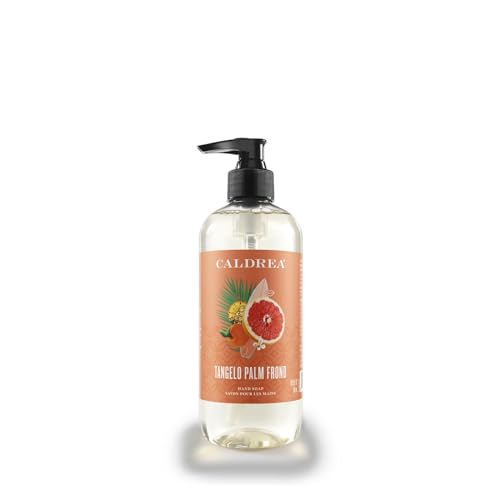
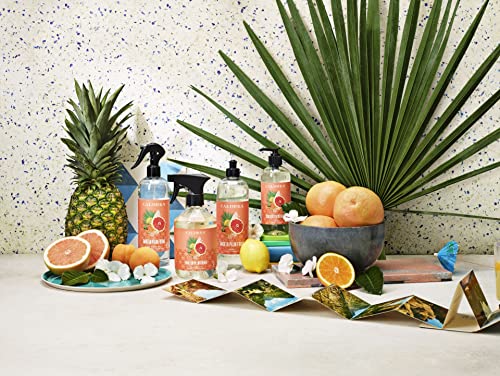
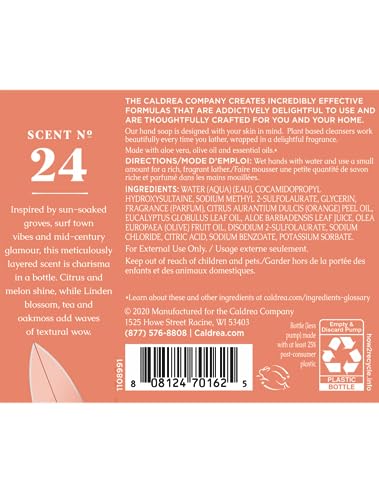
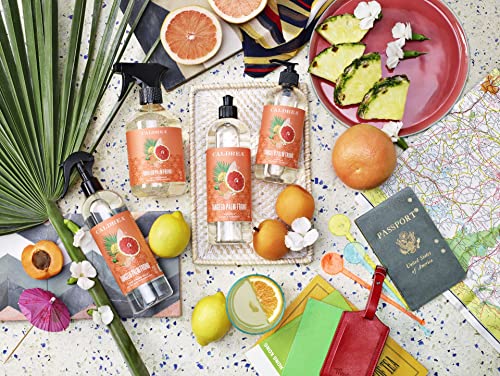
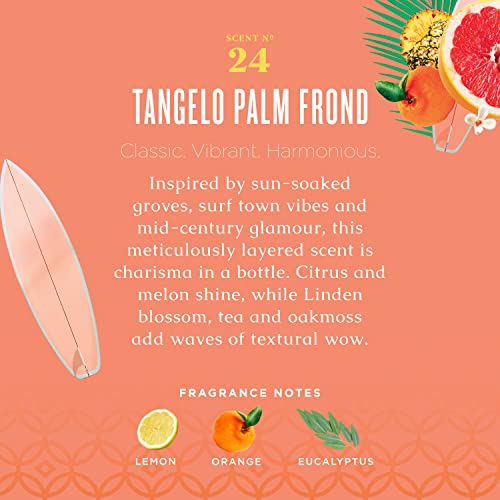
Caldrea Hand Soap - Moisturizing Aloe Vera & Olive Oil, Tangelo Palm Frond Scent - 10.8oz


Fragrance
High RiskFragrance refers to a mixture of aromatic compounds used in products to provide scent. It is commonly listed as 'fragrance' or 'parfum' on product labels and can serve various functions, including enhancing user experience and masking undesirable odors.
Sustai Insights
Fragrance offers functional benefits by improving product appeal; however, it poses significant health risks, notably a high likelihood of causing allergies and allergic contact dermatitis. Environmental risks include potential pollution and endocrine disruption, though its overall carcinogenicity is low. Regulatory bodies have noted concerns regarding its use, leading to a high-risk classification. Safe usage practices should be observed, and alternatives such as natural essential oils are recommended for those sensitive to synthetic fragrances.
Sodium Benzoate
Medium RiskSodium benzoate is a preservative commonly used in food and cosmetic products to prevent microbial growth and extend shelf life. It is derived from benzoic acid and is effective at low concentrations, often used in acidic environments like beverages and condiments.
Sustai Insights
Sodium benzoate serves effectively as a preservative, contributing to product stability and safety. It is generally recognized as safe with low concerns for carcinogenicity, allergies, and reproductive toxicity, though it faces moderate use restrictions in some regions. Environmental risks include its potential as a pollutant, but it does not bioaccumulate significantly. Regulatory bodies have issued advisories regarding its concentration in products. Overall, the risk level is assessed as medium, with safe usage practices recommended. Alternatives such as potassium sorbate may provide similar benefits with potentially lower restrictions.
Citrus Aurantium Dulcis (Orange) Peel Oil
Medium RiskCitrus aurantium dulcis (orange) peel oil is derived from the peel of oranges and is commonly used in cosmetic and personal care products for its fragrance and potential skin benefits. It is known for its aromatic properties and is often included in formulations aimed at enhancing scent profiles.
Sustai Insights
Citrus aurantium dulcis (orange) peel oil offers functional benefits such as providing a pleasant scent and potential antimicrobial properties. However, it poses a high allergy risk and may cause skin irritation in sensitive individuals. Environmental concerns include moderate persistence and potential to contribute to pollution. Regulatory warnings indicate restrictions on use in certain products. Overall, the risk level is assessed as medium, and users are advised to practice caution, particularly those with known allergies. Alternatives like sweet orange essential oil may provide similar benefits with potentially lower risks.
Potassium Sorbate
Medium RiskPotassium sorbate is a potassium salt of sorbic acid, primarily used as a preservative in food and cosmetic products. It inhibits the growth of molds, yeast, and some bacteria, extending the shelf life of products. It is commonly found in various formulations due to its effectiveness and low toxicity.
Sustai Insights
Potassium sorbate serves as an effective preservative, preventing microbial growth in food and cosmetic products, which is vital for safety and longevity. Although it has a low risk of carcinogenicity and developmental toxicity, there is a moderate concern regarding allergies and immunotoxicity. Environmentally, it poses minimal risks as it is not significantly bioaccumulative. Regulatory agencies have verified its use, although some products may face restrictions. Overall, it is assessed as a medium risk ingredient, with safe usage practices recommended, and alternatives such as natural preservatives could be considered.
Eucalyptus Globulus (Eucalyptus) Leaf Oil
Medium RiskEucalyptus globulus leaf oil is a volatile oil derived from the leaves of the eucalyptus tree, primarily used for its aromatic properties and as a potential antimicrobial agent in various products.
Sustai Insights
Eucalyptus globulus leaf oil offers functional benefits like fragrance and potential antimicrobial properties, supporting product efficacy. However, it presents high allergenic potential and moderate irritation concerns, which may pose health risks. Environmental risks include possible pollution and bioaccumulation. Regulatory restrictions are in place regarding its use in certain products. Overall, the risk level is medium, necessitating caution in usage and consideration of alternatives like tea tree oil or peppermint oil.
Citric Acid
Medium RiskCitric acid is an alpha hydroxy acid used in personal care products primarily for its role as a pH adjuster and natural preservative. It occurs naturally in citrus fruits and is commonly utilized in various formulations for its chelating properties and mild exfoliation benefits.
Sustai Insights
Citric acid offers functional benefits as an effective preservative and pH stabilizer, contributing to product longevity and stability. It is biodegradable and derived from renewable sources. Health risks are low, with minimal concerns regarding carcinogenicity, allergies, and reproductive toxicity. However, moderate use restrictions exist due to potential irritation at high concentrations. Environmental risks are limited, as citric acid is not known to accumulate in ecosystems. Regulatory agencies have no significant advisories against its use. Overall, it is assessed as a medium-risk ingredient, with safe usage practices recommended and alternatives available.
Disodium 2 Sulfolaurate
Low RiskDisodium 2 sulfolaurate is a surfactant and emulsifying agent commonly used in personal care products. It functions primarily to help cleanse, foaming, and stabilize formulations, enhancing the overall texture and performance of the product.
Sustai Insights
Disodium 2 sulfolaurate offers functional benefits as an effective surfactant, improving product stability and user experience. It is considered to have low health risks, with no significant concerns regarding carcinogenicity, allergenic potential, or reproductive toxicity. Environmental risks are minimal, with no evidence of bioaccumulation or significant pollution. Regulatory assessments indicate no current restrictions, affirming its safe use. Overall, the risk level is low, making it a suitable ingredient in formulated products.
Vegetarian Glycerin
Low RiskVegetarian glycerin, also known as glycerol, is a colorless, odorless, and viscous liquid derived from plant sources. It is primarily used as a humectant, solvent, and emollient in various personal care products, helping to retain moisture and improve texture.
Sustai Insights
Vegetarian glycerin offers functional benefits as an effective humectant, promoting hydration and skin smoothness. It is biodegradable and typically sustainably sourced. Health risks associated with glycerin are low, with no significant concerns for carcinogenicity, allergens, or reproductive toxicity. Environmental risks are minimal, and it is not subject to major regulatory warnings. Overall, the risk level for this ingredient is low, making it a safe choice in formulations. Safe usage practices include ensuring proper concentrations in products, and alternatives such as propylene glycol exist but may have differing properties.
Olea Europaea (Olive) Oil
Low RiskOlea europaea (olive) oil is derived from the ripe fruit of the olive tree. It is commonly used in cosmetic formulations primarily as a moisturizer and emollient due to its nourishing properties for the skin. It also serves as a carrier oil for other ingredients in formulations.
Sustai Insights
Olea europaea (olive) oil offers numerous functional benefits, including effective moisturization and enhanced skin absorption properties, making it suitable for various cosmetic applications. It is a biodegradable ingredient, contributing to sustainability when sourced responsibly. Health risks are low, with minimal concerns regarding carcinogenicity, allergenic potential, and developmental toxicity. Environmental risks are also low, with no significant bioaccumulation or pollution potential noted. Regulatory bodies do not impose restrictions on its use. Overall, olive oil presents a low risk profile, making it a favorable choice in cosmetic products.
Sea Salt
Low RiskSea salt is a mixture of inorganic salts derived primarily from the evaporation of seawater. It consists mainly of sodium chloride, with minor amounts of other minerals. Sea salt is commonly used as a seasoning and preservative in food products and may also have applications in cosmetics and personal care items.
Sustai Insights
Sea salt serves as an effective flavor enhancer and preservative, contributing to the taste and shelf-life of food products. It is generally considered safe with low risk for health concerns such as cancer, allergies, and reproductive toxicity. Environmental impact is minimal, as it does not contribute significantly to pollution or bioaccumulation. Regulatory bodies, including the FDA, currently do not impose restrictions on its use. Overall, the risk level associated with sea salt is low, making it a widely accepted ingredient with no significant adverse effects reported.
Sodium Methyl 2 Sulfolaurate
Low RiskSodium methyl 2 sulfolaurate is a surfactant primarily used in personal care and cleaning products. It functions to reduce surface tension, enabling better spreading and cleaning properties. This ingredient is typically derived from renewable resources and is noted for its mild nature in formulations.
Sustai Insights
Sodium methyl 2 sulfolaurate offers functional benefits as an effective surfactant, contributing to the cleaning efficacy of products while being derived from renewable sources, which supports sustainability. Health risks are considered low, with no significant concerns regarding carcinogenicity, allergies, or reproductive toxicity. Environmental risks are also low, as it does not bioaccumulate or contribute significantly to pollution. Regulatory bodies do not impose restrictions on its use. Overall, this ingredient presents a low-risk profile, with no notable adverse effects, making it a viable option in formulations.
Water
Low RiskWater is a clear, colorless liquid essential for various biological processes. It serves as a solvent in formulations, facilitating the dissolution of other ingredients and enhancing product texture and application. Additionally, water plays a crucial role in hydration and is a key component in many cosmetic and personal care products.
Sustai Insights
Water is an effective solvent and hydrator, contributing to the texture and efficacy of formulations. It is biodegradable and generally regarded as safe, with low concerns regarding carcinogenicity, allergies, and reproductive toxicity. However, excessive water usage can lead to environmental concerns, particularly regarding resource depletion. Regulatory bodies do not impose restrictions on water use in cosmetics. Overall, the risks associated with water are low, making it a safe and essential ingredient.
Cocamidopropyl Hydroxysultaine
Low RiskCocamidopropyl hydroxysultaine is a synthetic skin and hair conditioning agent commonly used in personal care products. It functions primarily as a surfactant, providing foaming and emulsifying properties, while also contributing to the conditioning of hair and skin.
Sustai Insights
Cocamidopropyl hydroxysultaine offers functional benefits as a mild surfactant and conditioning agent, with low concerns regarding carcinogenicity, allergies, and reproductive toxicity. It is generally regarded as safe with low irritation potential. Environmental assessments indicate low pollutant potential and minimal bioaccumulation. Regulatory bodies have not imposed significant restrictions on its use, aligning with low risk levels overall. Safe usage is advised, particularly for sensitive populations, and alternative gentle surfactants may be considered for those seeking greener options. In conclusion, this ingredient is classified as low risk.
Disodium 2 Sulfolaurate
Low RiskDisodium 2 sulfolaurate is a surfactant and emulsifying agent commonly used in personal care products. It functions primarily to help cleanse, foaming, and stabilize formulations, enhancing the overall texture and performance of the product.
Sustai Insights
Disodium 2 sulfolaurate offers functional benefits as an effective surfactant, improving product stability and user experience. It is considered to have low health risks, with no significant concerns regarding carcinogenicity, allergenic potential, or reproductive toxicity. Environmental risks are minimal, with no evidence of bioaccumulation or significant pollution. Regulatory assessments indicate no current restrictions, affirming its safe use. Overall, the risk level is low, making it a suitable ingredient in formulated products.
Fragrance
High RiskFragrance refers to a mixture of aromatic compounds used in products to provide scent. It is commonly listed as 'fragrance' or 'parfum' on product labels and can serve various functions, including enhancing user experience and masking undesirable odors.
Sustai Insights
Fragrance offers functional benefits by improving product appeal; however, it poses significant health risks, notably a high likelihood of causing allergies and allergic contact dermatitis. Environmental risks include potential pollution and endocrine disruption, though its overall carcinogenicity is low. Regulatory bodies have noted concerns regarding its use, leading to a high-risk classification. Safe usage practices should be observed, and alternatives such as natural essential oils are recommended for those sensitive to synthetic fragrances.
Vegetarian Glycerin
Low RiskVegetarian glycerin, also known as glycerol, is a colorless, odorless, and viscous liquid derived from plant sources. It is primarily used as a humectant, solvent, and emollient in various personal care products, helping to retain moisture and improve texture.
Sustai Insights
Vegetarian glycerin offers functional benefits as an effective humectant, promoting hydration and skin smoothness. It is biodegradable and typically sustainably sourced. Health risks associated with glycerin are low, with no significant concerns for carcinogenicity, allergens, or reproductive toxicity. Environmental risks are minimal, and it is not subject to major regulatory warnings. Overall, the risk level for this ingredient is low, making it a safe choice in formulations. Safe usage practices include ensuring proper concentrations in products, and alternatives such as propylene glycol exist but may have differing properties.
Sodium Benzoate
Medium RiskSodium benzoate is a preservative commonly used in food and cosmetic products to prevent microbial growth and extend shelf life. It is derived from benzoic acid and is effective at low concentrations, often used in acidic environments like beverages and condiments.
Sustai Insights
Sodium benzoate serves effectively as a preservative, contributing to product stability and safety. It is generally recognized as safe with low concerns for carcinogenicity, allergies, and reproductive toxicity, though it faces moderate use restrictions in some regions. Environmental risks include its potential as a pollutant, but it does not bioaccumulate significantly. Regulatory bodies have issued advisories regarding its concentration in products. Overall, the risk level is assessed as medium, with safe usage practices recommended. Alternatives such as potassium sorbate may provide similar benefits with potentially lower restrictions.
Citrus Aurantium Dulcis (Orange) Peel Oil
Medium RiskCitrus aurantium dulcis (orange) peel oil is derived from the peel of oranges and is commonly used in cosmetic and personal care products for its fragrance and potential skin benefits. It is known for its aromatic properties and is often included in formulations aimed at enhancing scent profiles.
Sustai Insights
Citrus aurantium dulcis (orange) peel oil offers functional benefits such as providing a pleasant scent and potential antimicrobial properties. However, it poses a high allergy risk and may cause skin irritation in sensitive individuals. Environmental concerns include moderate persistence and potential to contribute to pollution. Regulatory warnings indicate restrictions on use in certain products. Overall, the risk level is assessed as medium, and users are advised to practice caution, particularly those with known allergies. Alternatives like sweet orange essential oil may provide similar benefits with potentially lower risks.
Potassium Sorbate
Medium RiskPotassium sorbate is a potassium salt of sorbic acid, primarily used as a preservative in food and cosmetic products. It inhibits the growth of molds, yeast, and some bacteria, extending the shelf life of products. It is commonly found in various formulations due to its effectiveness and low toxicity.
Sustai Insights
Potassium sorbate serves as an effective preservative, preventing microbial growth in food and cosmetic products, which is vital for safety and longevity. Although it has a low risk of carcinogenicity and developmental toxicity, there is a moderate concern regarding allergies and immunotoxicity. Environmentally, it poses minimal risks as it is not significantly bioaccumulative. Regulatory agencies have verified its use, although some products may face restrictions. Overall, it is assessed as a medium risk ingredient, with safe usage practices recommended, and alternatives such as natural preservatives could be considered.
Olea Europaea (Olive) Oil
Low RiskOlea europaea (olive) oil is derived from the ripe fruit of the olive tree. It is commonly used in cosmetic formulations primarily as a moisturizer and emollient due to its nourishing properties for the skin. It also serves as a carrier oil for other ingredients in formulations.
Sustai Insights
Olea europaea (olive) oil offers numerous functional benefits, including effective moisturization and enhanced skin absorption properties, making it suitable for various cosmetic applications. It is a biodegradable ingredient, contributing to sustainability when sourced responsibly. Health risks are low, with minimal concerns regarding carcinogenicity, allergenic potential, and developmental toxicity. Environmental risks are also low, with no significant bioaccumulation or pollution potential noted. Regulatory bodies do not impose restrictions on its use. Overall, olive oil presents a low risk profile, making it a favorable choice in cosmetic products.
Sea Salt
Low RiskSea salt is a mixture of inorganic salts derived primarily from the evaporation of seawater. It consists mainly of sodium chloride, with minor amounts of other minerals. Sea salt is commonly used as a seasoning and preservative in food products and may also have applications in cosmetics and personal care items.
Sustai Insights
Sea salt serves as an effective flavor enhancer and preservative, contributing to the taste and shelf-life of food products. It is generally considered safe with low risk for health concerns such as cancer, allergies, and reproductive toxicity. Environmental impact is minimal, as it does not contribute significantly to pollution or bioaccumulation. Regulatory bodies, including the FDA, currently do not impose restrictions on its use. Overall, the risk level associated with sea salt is low, making it a widely accepted ingredient with no significant adverse effects reported.
Eucalyptus Globulus (Eucalyptus) Leaf Oil
Medium RiskEucalyptus globulus leaf oil is a volatile oil derived from the leaves of the eucalyptus tree, primarily used for its aromatic properties and as a potential antimicrobial agent in various products.
Sustai Insights
Eucalyptus globulus leaf oil offers functional benefits like fragrance and potential antimicrobial properties, supporting product efficacy. However, it presents high allergenic potential and moderate irritation concerns, which may pose health risks. Environmental risks include possible pollution and bioaccumulation. Regulatory restrictions are in place regarding its use in certain products. Overall, the risk level is medium, necessitating caution in usage and consideration of alternatives like tea tree oil or peppermint oil.
Citric Acid
Medium RiskCitric acid is an alpha hydroxy acid used in personal care products primarily for its role as a pH adjuster and natural preservative. It occurs naturally in citrus fruits and is commonly utilized in various formulations for its chelating properties and mild exfoliation benefits.
Sustai Insights
Citric acid offers functional benefits as an effective preservative and pH stabilizer, contributing to product longevity and stability. It is biodegradable and derived from renewable sources. Health risks are low, with minimal concerns regarding carcinogenicity, allergies, and reproductive toxicity. However, moderate use restrictions exist due to potential irritation at high concentrations. Environmental risks are limited, as citric acid is not known to accumulate in ecosystems. Regulatory agencies have no significant advisories against its use. Overall, it is assessed as a medium-risk ingredient, with safe usage practices recommended and alternatives available.
Sodium Methyl 2 Sulfolaurate
Low RiskSodium methyl 2 sulfolaurate is a surfactant primarily used in personal care and cleaning products. It functions to reduce surface tension, enabling better spreading and cleaning properties. This ingredient is typically derived from renewable resources and is noted for its mild nature in formulations.
Sustai Insights
Sodium methyl 2 sulfolaurate offers functional benefits as an effective surfactant, contributing to the cleaning efficacy of products while being derived from renewable sources, which supports sustainability. Health risks are considered low, with no significant concerns regarding carcinogenicity, allergies, or reproductive toxicity. Environmental risks are also low, as it does not bioaccumulate or contribute significantly to pollution. Regulatory bodies do not impose restrictions on its use. Overall, this ingredient presents a low-risk profile, with no notable adverse effects, making it a viable option in formulations.
Water
Low RiskWater is a clear, colorless liquid essential for various biological processes. It serves as a solvent in formulations, facilitating the dissolution of other ingredients and enhancing product texture and application. Additionally, water plays a crucial role in hydration and is a key component in many cosmetic and personal care products.
Sustai Insights
Water is an effective solvent and hydrator, contributing to the texture and efficacy of formulations. It is biodegradable and generally regarded as safe, with low concerns regarding carcinogenicity, allergies, and reproductive toxicity. However, excessive water usage can lead to environmental concerns, particularly regarding resource depletion. Regulatory bodies do not impose restrictions on water use in cosmetics. Overall, the risks associated with water are low, making it a safe and essential ingredient.
Cocamidopropyl Hydroxysultaine
Low RiskCocamidopropyl hydroxysultaine is a synthetic skin and hair conditioning agent commonly used in personal care products. It functions primarily as a surfactant, providing foaming and emulsifying properties, while also contributing to the conditioning of hair and skin.
Sustai Insights
Cocamidopropyl hydroxysultaine offers functional benefits as a mild surfactant and conditioning agent, with low concerns regarding carcinogenicity, allergies, and reproductive toxicity. It is generally regarded as safe with low irritation potential. Environmental assessments indicate low pollutant potential and minimal bioaccumulation. Regulatory bodies have not imposed significant restrictions on its use, aligning with low risk levels overall. Safe usage is advised, particularly for sensitive populations, and alternative gentle surfactants may be considered for those seeking greener options. In conclusion, this ingredient is classified as low risk.
Experience the luxurious cleansing power of Caldrea Hand Wash Soap, infused with Aloe Vera Gel and Olive Oil, designed to nourish your skin while effectively removing dirt and impurities. The refreshing Tangelo Palm Frond scent transports you to a vibrant day along the Pacific. Crafted for the environmentally conscious, this hand soap features a unique blend of essential oils and is free from harmful ingredients like phthalates and parabens, making it a safe choice for your home.
- Gentle Yet Effective Cleanse: Combines Aloe Vera and Olive Oil for a moisturizing wash that cleanses without drying skin.
- Eco-Friendly Ingredients: Made with vegetable-derived glycerin and essential oils, ensuring a sustainable choice.
- Dual Purpose: Perfect for hand washing and gentle enough to use on delicate clothing items.
- Safe and Non-Toxic: Free from harmful chemicals, providing peace of mind for families.
- Refreshing Scent: Enjoy the uplifting aroma of Tangelo Palm Frond, adding a delightful touch to your daily routine.
Subscribe & Save with Sustai
- Best Price Guarantee: Always enjoy the lowest prices on sustainable home essentials.
- No Surprises: We’ll notify you before shipping. No hidden fees, ever.
- You’re in Charge: Change, pause, or cancel your subscription anytime with ease.
- Eco-Friendly Deliveries: Our grouped shipments mean less packaging and lower emissions.
Join us on a sustainable journey. Special offers for a limited time! Prices and promotions may change.
Recommended Products
Experience the luxurious cleansing power of Caldrea Hand Wash Soap, infused with Aloe Vera Gel and Olive Oil, designed to nourish your skin while effectively removing dirt and impurities. The refreshing Tangelo Palm Frond scent transports you to a vibrant day along the Pacific. Crafted for the environmentally conscious, this hand soap features a unique blend of essential oils and is free from harmful ingredients like phthalates and parabens, making it a safe choice for your home.
- Gentle Yet Effective Cleanse: Combines Aloe Vera and Olive Oil for a moisturizing wash that cleanses without drying skin.
- Eco-Friendly Ingredients: Made with vegetable-derived glycerin and essential oils, ensuring a sustainable choice.
- Dual Purpose: Perfect for hand washing and gentle enough to use on delicate clothing items.
- Safe and Non-Toxic: Free from harmful chemicals, providing peace of mind for families.
- Refreshing Scent: Enjoy the uplifting aroma of Tangelo Palm Frond, adding a delightful touch to your daily routine.

You can have at most 2 Sustainable Steals products in your cart
Customer Reviews
Customers’ View
Customers express a strong appreciation for the Caldrea Hand Soap, noting its gentle cleansing properties and nourishing ingredients. Many reviews highlight the luxurious feel and upscale scent, with users mentioning that it leaves their hands soft and moisturized, even with frequent washing. The inclusion of natural ingredients like aloe vera and olive oil is particularly appealing to health-conscious consumers, as it aligns with their desire for safe and effective products. Additionally, the absence of harmful additives resonates with environmentally aware individuals. While some customers acknowledge the product's higher price point, the overall sentiment reflects satisfaction with its quality and performance, making it a favored choice among those prioritizing both efficacy and sustainability.
AI-generated from the text of customer reviewsThis product is rated 4.6 of 5.0 stars.
It has received 5 reviews.




